#galaxy formation
Text
Excerpt:
"For over 30 years it was thought that these disk galaxies were rare in the early universe due to the common violent encounters that galaxies undergo," lead study author Leonardo Ferreira, an astronomer at the University of Victoria in Canada, said in a statement. "The fact that JWST finds so many is another sign of the power of this instrument and that the structures of galaxies form earlier in the universe, much earlier in fact, than anyone had anticipated."
19 notes
·
View notes
Photo
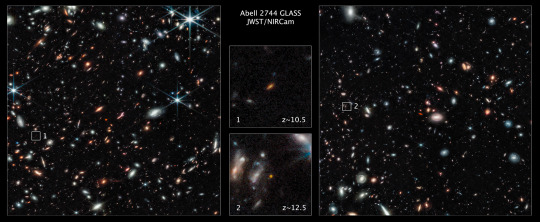
“Two of the farthest galaxies seen to date are captured in these Webb Space Telescope pictures of the outer regions of the giant galaxy cluster Abell 2744. The galaxies are not inside the cluster, but many billions of light-years farther behind it. The galaxy labeled (1) existed only 450 million years after the big bang. The galaxy labeled (2) existed 350 million years after the big bang.”
These galaxies discovered by Webb just a few days after it has begun science operations are already forcing scientists to rethink their theories on the evolution of the universe, pushing back the birth of the first galaxies to just 100 million years after the big bang, and possibly providing our first known glimpse of the to-this-point only theorized “Population III” stars: “the first stars ever born, blazing at blistering temperatures and made up only of primordial hydrogen and helium.”
#webb space telescope#james webb#telescope#space telescope#webb#galaxies#universe#science#astronomy#nasa#population iii#stars#big bang#galaxy formation#oldest galaxies#oldest stars#first stars#abell 2744
69 notes
·
View notes
Text
Milky Way-like Galaxy Found in the Early Universe - Technology Org
New Post has been published on https://thedigitalinsider.com/milky-way-like-galaxy-found-in-the-early-universe-technology-org/
Milky Way-like Galaxy Found in the Early Universe - Technology Org
Using the James Webb Space Telescope, an international team, including astronomer Alexander de la Vega of the University of California, Riverside, has discovered the most distant barred spiral galaxy similar to the Milky Way observed to date.
Artistic representation of the spiral barred galaxy ceers-2112, observed in the early Uni-verse. The Earth is reflected on an illusive bubble surrounding the galaxy, recalling the connection between the Milky Way and ceers-2112. Image credit: Luca Costantin/CAB/CSIC-INTA
Until now it was believed that barred spiral galaxies like the Milky Way could not be observed before the universe, estimated to be 13.8 billion years old, reached half of its current age.
The research, published in Nature, was led by scientists at the Centro de Astrobiología in Spain.
“This galaxy, named ceers-2112, formed soon after the Big Bang,” said coauthor de la Vega, a postdoctoral researcher in the Department of Physics and Astronomy. “Finding ceers-2112 shows that galaxies in the early universe could be as ordered as the Milky Way. This is surprising because galaxies were much more chaotic in the early universe and very few had similar structures to the Milky Way.”
Ceers-2112 has a bar in its center. De la Vega explained that a galactic bar is a structure, made of stars, within galaxies. Galactic bars resemble bars in our everyday lives, such as a candy bar. It is possible to find bars in non-spiral galaxies, he said, but they are very rare.
Milky Way in the night sky – illustrative photo. Image credit: Jeremy Thomas via Unsplash, free license
“Nearly all bars are found in spiral galaxies,” said de la Vega, who joined UCR last year after receiving his doctoral degree in astronomy at Johns Hopkins University. “The bar in ceers-2112 suggests that galaxies matured and became ordered much faster than we previously thought, which means some aspects of our theories of galaxy formation and evolution need revision.”
Astronomers’ previous understanding of galaxy evolution was that it took several billion years for galaxies to become ordered enough to develop bars.
“The discovery of ceers-2112 shows that it can happen in only a fraction of that time, in about one billion years or less,” de la Vega said.
According to him, galactic bars are thought to form in spiral galaxies with stars that rotate in an ordered fashion, the way they do in the Milky Way.
“In such galaxies, bars can form spontaneously due to instabilities in the spiral structure or gravitational effects from a neighboring galaxy,” de la Vega said. “In the past, when the universe was very young, galaxies were unstable and chaotic. It was thought that bars could not form or last long in galaxies in the early universe.”
The discovery of ceers-2112 is expected to change at least two aspects of astronomy.
“First, theoretical models of galaxy formation and evolution will need to account for some galaxies becoming stable enough to host bars very early in the universe’s history,” de la Vega said.
“These models may need to adjust how much dark matter makes up galaxies in the early universe, as dark matter is believed to affect the rate at which bars form. Second, the discovery of ceers-2112 demonstrates that structures like bars can be detected when the universe was very young. This is important because galaxies in the distant past were smaller than they are now, which makes finding bars harder. The discovery of ceers-2112 paves the way for more bars to be discovered in the young universe.”
De la Vega helped the research team by estimating the redshift and properties of ceers-2112. He also contributed to the interpretation of the measurements.
“Redshift is an observable property of a galaxy that indicates how far away it is and how far back in time the galaxy is seen, which is a consequence of the finite speed of light,” he said.
What surprised de la Vega most about the discovery of ceers-2112 is how well the properties of its bar could be constrained.
“Initially, I thought detecting and estimating properties of bars in galaxies like ceers-2112 would be fraught with measurement uncertainties,” he said. “But the power of the James Webb Space Telescope and the expertise of our research team helped us place strong constraints on the size and shape of the bar.”
At UCR, de la Vega oversees astronomy outreach. He plans telescope nights on and off campus, and visits to local schools to give presentations on astronomy. He also leads the public astronomy talk series “Cosmic Thursdays” as well as one-off events for special occasions, such as viewing parties for eclipses.
The research paper is titled “A Milky Way-like barred spiral galaxy at a redshift of 3.”
Source: UC Riverside
You can offer your link to a page which is relevant to the topic of this post.
#Astronomy#Astronomy news#big bang#billion#Dark#dark matter#earth#effects#Events#Evolution#Explained#form#Fraction#galaxies#Galaxy#galaxy formation#History#how#international team#it#James Webb Space Telescope#Johns Hopkins#LED#LESS#Light#Link#matter#measurements#Milky Way#nature
2 notes
·
View notes
Text
A Theory On Black Holes
Today i just want to talk about black holes.
So we all know that black holes can be very dangerous, but aren't close enough to earth to pose a danger to us.
If you were to get too close to a black hole you would go through a process called "spaghettification" which is when the gravitational force of the BH causes you to stretch in the direction of the BH (and compressed perpendicular to it as you fall). It is a very painful process.
Spaghettification can happen to anything, there just needs to be a strong enough gravitational field.
Now, that i have explained spaghettification i can move on to the theory part.
(I actually have 2 theories on black holes.)
So black holes basically suck in everything around them, and i was wondering what would happen to all that matter if a BH was to explode. I came to a conclusion that maybe, just maybe a new galaxy could form. I know it's far fetched but that's why it is called a theory.
To go into more detail, all the matter that the BH swallowed, has to go somewhere right? So where would it go if the BH exploded? It could form new planets and stars, create entirely new solar systems.
The only thing is scientists created computer models to understand the formation of galaxies and it indicated that they are formed when dark matter joins and groups together.
It could be possible though, maybe.
Let me know if you want to know my other theory. :)
3 notes
·
View notes
Text
Black holes are born from the collapse of giant stars and grow by gorging on gas, dust, stars and other black holes.
Quasars by ejecting gas that flows too fast to be consumed by growing stars, quasars quench the ability of stars to form in the region
Abstract
1. Introduction
2. Observations and Data Reduction
3. Results
4. Molecular Gas Outflow
5. Discussion
6. Summary
Acknowledgments
Footnotes
Show References
0 notes
Text
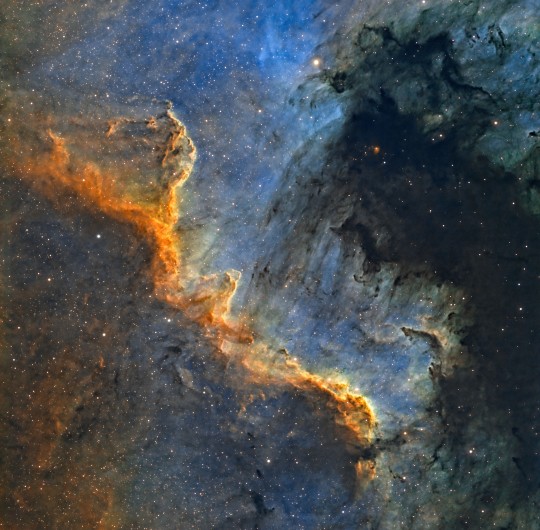
Wall of Star Formation
#astronomy#night#sky#stars#space#nasa#science#universe#nebula#galaxy#cosmos#cygnus#wall of star formation
4K notes
·
View notes
Text
Webb Telescope Rules Out Thick Carbon Dioxide Atmosphere for TRAPPIST-1 c
NASA’s James Webb Space Telescope has conducted observations of the exoplanet TRAPPIST-1 c and made a significant discovery. Despite being similar in size to Venus and receiving comparable levels of radiation from its star, Webb’s findings indicate that TRAPPIST-1 c does not possess Venus’s thick carbon dioxide-rich atmosphere. If an atmosphere exists on TRAPPIST-1 c, it is likely to be very…
View On WordPress
#Ariane 5 rocket#Cosmic Microwave Background#Deep space observations#Exoplanets#Fine Guidance Sensor/Near InfraRed Imager and Slitless Spectrograph (FGS/NIRISS)#Galaxy formation#Hubble Space Telescope successor#Infrared Astronomy#Infrared detectors#James Webb Space Telescope (JWST)#Launch#Mid-Infrared Instrument (MIRI)#Mirror segments#Multi-object spectroscopy#NASA#Near InfraRed Spectrograph (NIRSpec)#Near-Infrared Camera (NIRCam)#Space telescope#Stellar populations#Sunshield#Transiting exoplanets#Universe formation and evolution#Webb Science Operations Center (JSOC)
0 notes
Text
"Black Matter: Exploring the Elusive and Mysterious Building Blocks of the Universe"

Black matter, also known as dark matter, is a hypothetical form of matter that makes up approximately 85% of the matter in the universe. It does not interact with light, and as such, it cannot be directly observed or detected by traditional means. Despite its elusive nature, scientists believe that it plays a crucial role in the formation and evolution of galaxies.
The idea of dark matter was first proposed in the 1930s by Swiss astronomer Fritz Zwicky. Zwicky observed the movement of galaxies in galaxy clusters and found that they were moving much faster than they should be based on the amount of visible matter present. He suggested that there must be some other form of matter that was responsible for this additional gravitational force.
Since then, numerous studies have been conducted to try and detect dark matter. While it cannot be observed directly, its existence has been inferred through its gravitational effects on visible matter. Scientists have used a variety of methods to study dark matter, including observing the motion of stars within galaxies and analyzing the cosmic microwave background radiation left over from the Big Bang.
One of the most widely accepted theories of dark matter is that it is made up of particles that do not interact with electromagnetic radiation. These particles are known as weakly interacting massive particles (WIMPs). While WIMPs have not been detected directly, scientists have been able to narrow down their possible properties based on their expected interactions with other matter.
Another theory is that dark matter is made up of black holes that formed in the early universe. These black holes would be too small to be observed directly but would still have a significant gravitational effect on their surroundings.
Despite decades of research, the nature of dark matter remains a mystery. While there is strong evidence to support its existence, scientists have not yet been able to detect it directly. This has led to much speculation and debate in the scientific community, with some researchers suggesting that the current understanding of gravity may need to be revised in order to explain the behavior of galaxies.
In conclusion, black matter, or dark matter, is a mysterious and elusive form of matter that makes up the vast majority of the matter in the universe. While its existence has been inferred through its gravitational effects, scientists have yet to detect it directly. Understanding dark matter is crucial for our understanding of the universe and its evolution, and research in this field is ongoing.
#Black matter#Dark matter#Universe#Hypothetical matter#Gravitational effects#Black holes#Galaxy formation#Scientific research
0 notes
Text

Less "optimus and bumblebee fight megatron and starscream" and more "motley crew of ocean-themed beastformers try to get their old band back together and have to trek through various galaxies to find their missing members"
#just like some small-scale spinoffs would be so fun for tf#just a couple of cartoon shorts or comic formats like tf galaxies#resi.txt#transformers#maccadam#that thing with the band isn't a joke btw#i really want to see all the squid-bots like skylla and a#all the shark-bots interacting also somehow rockbuster is the “manager” who had the idea of getting the band back together#after the great warin the first place
2K notes
·
View notes
Note
Can you do a Rocket!reader (romantic) where Rocket constantly looks for physical attention from y/n and he doesn't want the others to know but Quill walks in and Rocket doesn't notice it but when he does he ets all defensive and flustered?
Yes
It's a slow morning on the Milano. You're having breakfast with Quill in the kitchen when Rocket pokes his head in the room.
"Y/n, you busy right now?"
You shake your head. "i'm almost done with food, why?"
He points with his thumb over his shoulder. "I need help with one of the vents in my workshop,"
"Alright, I'll be there," He nods, walking back deep into the ship. Cleaning your plate and putting it in the sink, you follow Rockets footsteps.
Walking through the threshold, you're shocked when the door slams shut. Rocket grabs the front of your shirt, pulling you over to the wall. Putting your arms up to catch you, they land on either side of Rocket.
"Took you long enough," He murmurs, pressing a kiss to your chin.
You roll your eyes, regaining your balance, pressing yourself against him, pushing him into the wall. You hardly notice the stool he's standing on to almost be eye level. "You could've told me this is what you wanted,"
He shrugs. "Was gonna, then I saw that Quill was there, and I don't wanna deal with that shit,"
"Yeah, I don't wanna deal with this shit either," A third voice scares you both, you pulling back, seeing Quill standing on the other side of the room.
Rocket, in a panic, shoves your chest away, jumping down from the stool he was stood on. "Quill, what the hell-!"
"Oh, don't 'what the hell' me! This is both of our workshops! It has two doors!" Quill yelled, face getting red.
"You could've knocked!" Rocket retorted.
Quill looks between you both, a smirk forming on his face. "Didn't know you liked each other like that-"
"Don't play that way, Quill, get out!" Rockets tail was puffed out, his ears back. You were sure if he could, he'd be bright red.
"I'm just saying, I didn't think you'd be the one to like getting pushed-"
"I said, get out!" Rocket yelled, snapping and snarling at Quills legs. The man yelped, jumping and moving back.
"Alright, alright, I'm going!" Quill rushes out the second door, slamming it behind him.
Rocket sighs, hands on his hips. You clear your throat to get his attention.
"Wanna try that again?"
#im trying a more 'informal' format#just a quick little blurb#hope you like it!!!!#guardians of the galaxy#guardians of the galaxy headcannons#guardians of the galaxy imagine#gotg#gotg headcannons#gotg imagines#guardians of the galaxy vol 2#guardians of the galaxy vol 2 headcannons#guardians of the galaxy vol 2 imagine#gotg2#gotg2 imagine#gotg2 headcannons#rocket#rocket raccoon#rocket raccoon imagines#rocket racoon headcannons#rocket racoon x reader#peter quill#it is my works#thanks for the ask!
520 notes
·
View notes
Text






The next batch of The Hitchhiker's Guide to the Galaxy as text posts in honor of my completion of Life, The Universe, and Everything
#first one is formatted a bit weird so you may have to click on that one#that being said it's my favorite so please enjoy these!#the hitchhiker's guide to the galaxy#h2g2#ford prefect#arthur dent#zaphod beeblebrox#trillian astra#marvin the paranoid android#h2g2 textposts#a little light reading#crab’s blabbering
77 notes
·
View notes
Text
Astronomers Spot Oldest ‘Dead’ Galaxy Yet Observed - Technology Org
New Post has been published on https://thedigitalinsider.com/astronomers-spot-oldest-dead-galaxy-yet-observed-technology-org/
Astronomers Spot Oldest ‘Dead’ Galaxy Yet Observed - Technology Org
A galaxy that suddenly stopped forming new stars more than 13 billion years ago has been observed by astronomers.
False-colour JWST image of a small fraction of the GOODS South field, with JADES-GS-z7-01-QU highlighted. Image credit: JADES Collaboration
Using the James Webb Space Telescope, an international team of astronomers led by the University of Cambridge have spotted a ‘dead’ galaxy when the universe was just 700 million years old, the oldest such galaxy ever observed.
This galaxy appears to have lived fast and died young: star formation happened quickly and stopped almost as quickly, which is unexpected for so early in the universe’s evolution. However, it is unclear whether this galaxy’s ‘quenched’ state is temporary or permanent and what caused it to stop forming new stars.
The results, reported in the journal Nature, could help astronomers understand how and why galaxies stop forming new stars and whether the factors affecting star formation have changed over billions of years.
“The first few hundred million years of the universe was a very active phase, with lots of gas clouds collapsing to form new stars,” said Tobias Looser from the Kavli Institute for Cosmology, the paper’s first author. “Galaxies need a rich supply of gas to form new stars, and the early universe was like an all-you-can-eat buffet.”
“It’s only later in the universe that we start to see galaxies stop forming stars, whether that’s due to a black hole or something else,” said co-author Dr Francesco D’Eugenio, also from the Kavli Institute for Cosmology.
Astronomers believe that star formation can be slowed or stopped by different factors, all of which will starve a galaxy of the gas it needs to form new stars. Internal factors, such as a supermassive black hole or feedback from star formation, can push gas out of the galaxy, causing star formation to stop rapidly. Alternatively, gas can be consumed very quickly by star formation, without being promptly replenished by fresh gas from the surroundings of the galaxy, resulting in galaxy starvation.
“We’re not sure if any of those scenarios can explain what we’ve now seen with Webb,” said co-author Professor Roberto Maiolino. “Until now, to understand the early universe, we’ve used models based on the modern universe. But now that we can see so much further back in time, and observe that the star formation was quenched so rapidly in this galaxy, models based on the modern universe may need to be revisited.”
Using data from JADES (JWST Advanced Deep Extragalactic Survey), the astronomers determined that this galaxy experienced a short and intense period of star formation over a period between 30 and 90 million years. But between 10 and 20 million years before the point in time where it was observed with Webb, star formation suddenly stopped.
“Everything seems to happen faster and more dramatically in the early universe, and that might include galaxies moving from a star-forming phase to dormant or quenched,” said Looser.
Astronomers have previously observed dead galaxies in the early universe, but this galaxy is the oldest yet – just 700 million years after the big bang, more than 13 billion years ago. This observation is one of the deepest yet made with Webb.
In addition to the oldest, this galaxy is also relatively low mass – about the same as the Small Magellanic Cloud (SMC), a dwarf galaxy near the Milky Way, although the SMC is still forming new stars. Other quenched galaxies in the early universe have been far more massive, but Webb’s improved sensitivity allows smaller and fainter galaxies to be observed and analysed.
The astronomers say that although it appears dead at the time of observation, it’s possible that in the roughly 13 billion years since, this galaxy may have come back to life and started forming new stars again.
“We’re looking for other galaxies like this one in the early universe, which will help us place some constraints on how and why galaxies stop forming new stars,” said D’Eugenio. “It could be the case that galaxies in the early universe ‘die’ and then burst back to life – we’ll need more observations to help us figure that out.”
Source: Cambridge University
You can offer your link to a page which is relevant to the topic of this post.
#Astronomy news#big bang#billion#black hole#Cloud#clouds#Collaboration#cosmology#data#dwarf#Evolution#Experienced#form#Fraction#Fundamental physics news#galaxies#Galaxy#galaxy formation#gas#how#international team#it#James Webb Space Telescope#jwst#Kavli Institute#LED#life#Link#mass#Milky Way
1 note
·
View note
Text

This magnificent spiral galaxy is Messier 64 (M64), often called the Black Eye Galaxy or the Sleeping Beauty Galaxy. It’s nickname comes from its dark-lidded appearance in telescopic views. The spiral's central region, about 7,400 light-years across, is pictured in this reprocessed image from the Hubble Space Telescope. M64 lies some 17 million light-years away in the otherwise well-groomed northern constellation Coma Berenices. The enormous dust clouds partially obscuring M64's central region are filled with young, blue star clusters and the reddish glow of hydrogen associated with star forming regions. But imposing clouds of dust are not this galaxy's only peculiar feature. Observations show that M64 is actually composed of two concentric, counter-rotating systems. While all the stars in M64 rotate in the same direction as the interstellar gas in the galaxy's central region, gas in the outer regions, extending to about 40,000 light-years, rotates in the opposite direction. The dusty eye and bizarre rotation are likely the result of a billion year old merger of two different galaxies.
Image Credit: NASA, ESA, Hubble, HLA; Processing: Jonathan Lodge
#astronomy#space#science#universe#galaxy#spiral#spiral galaxy#black eye#black eye galaxy#sleeping beauty#sleeping beauty galaxy#m64#messier#stars#dust#gas#star formation#young stars#follow#like#reblog#the first star#the first starr#thefirststar#thefirststarr#nasa#apod#tumblr#blog#blogger
163 notes
·
View notes
Note
Meta Knight disobeying direct orders from Nightmare, then joining the GSA and disobeying protocol set by Sir Arthur and other generals often, and finally in Dreamland Meta Knight follows King Dedede’s orders maybe half the time.
I think I’m sensing a pattern.
decided to make a chart of how probable it was for MK to listen when he was in the GSA because of this. There's a fair chance that at anytime he'll decide "hm, I think I will just do whatever I want"

#post's rambles#post's doodle bin#kirby right back at ya#galaxy soldier army#embracing the need to overcomplicate every hc by doing it in fun picture format#if you're surprised that Arthur is so far up there#it's because once upon a time MK did actually listen to him!#before The Horrors(tm) that is
285 notes
·
View notes
Text
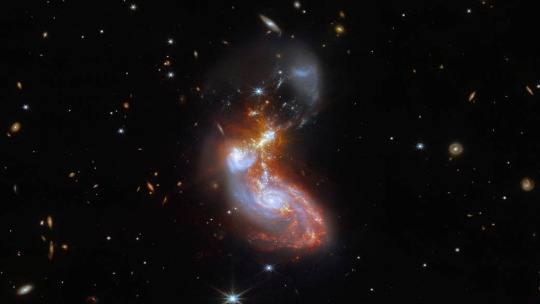



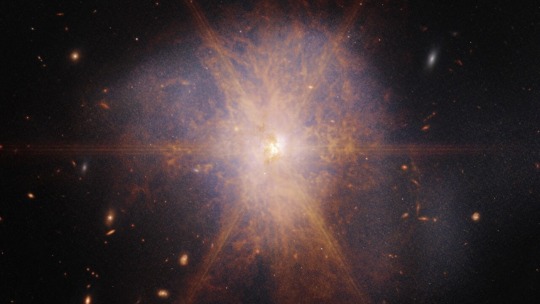



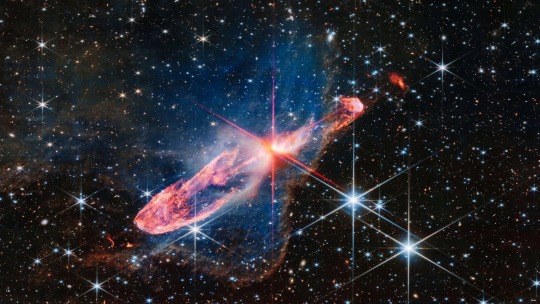

on love and hope in the universe, even through all the destruction
II ZW 96 galaxy collision // The Beatrice Letters - Lemony Snicket // the galaxy NGC 3256 - a wreckage after a cosmic collision // What My Bones Know - Stephanie Foo // light from a burst of star birth after a collision between galaxies // me about you // IC 1623 - two galaxies colliding // Abstract (Psychopomp) - Hozier // a pair of actively forming stars - Herbig-Haro 46/47 // Undertale
#web weaving#web weave#i dont know#yes i included that undertale quote fuck you#love#space#galaxy collisions#lemony snicket#what my bones know#hozier🙏🏻#okay i think that is all the organisational stuff#this is obviously about him but we move#the basic thought is how even if something can be messy and can shake you to your core. something so beautiful can come from it#sometimes love feels like a shock to my system.like oh i didnt know i could feel this much#but it lights everything up so much#like the starbursts after a galaxy collision or the first light or a new star formation#anyways that is what i was going for#I think all pics are JWST
51 notes
·
View notes
Text

◠◡ Rosweetphrasic ... ♡
[PT: Rosweetphasic. End PT]



[ID: Three almost identical seventeen striped flags The first and last five stripes have semicircles facing inwards. The colors, from top to bottom, are red, pastel red, red, pastel red, red, rose pink, pastel pink, pale pink, white, pale pink, pastel pink, rose pink, red, pastel red, red, pastel red, and red. In the center of the middle flag, there is a drawing of a pink rose. Said rose is not on the other two flags. End ID]
♥︎ ⁝ A gender related to the phrase "A rose by any other name would smell just as sweet."
⋯ Accidental recoin of Rojurosequotic by Identidiary! Please support the original post; simply view this one as an alternate flag of sorts.

#☆ : galaxies#mogai#liom#liomogai#mogai coining#mogai term#mogai flag#liom term#liom flag#liom coining#actually mogai#actually liom#mogai gender#xenogender#neogender#lovegender#rosegender#genderphrasic#phrasic#phrasegender#rosweetphrasic#tried a new coining post format ... i hope it looks nice?
21 notes
·
View notes